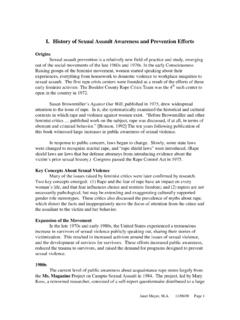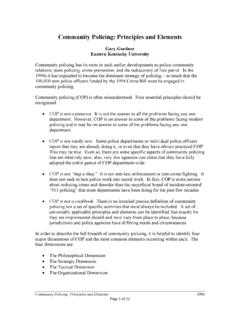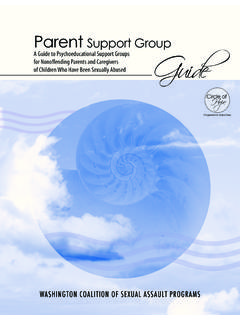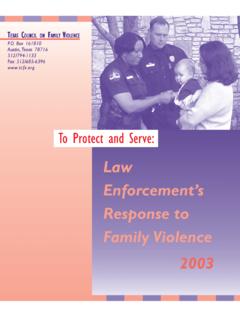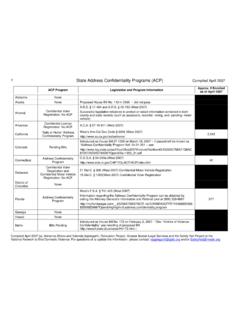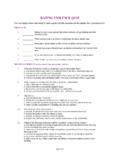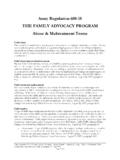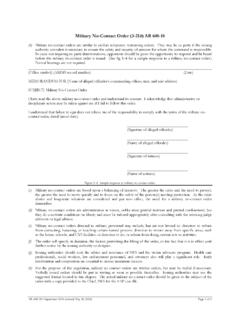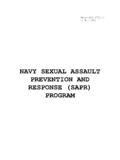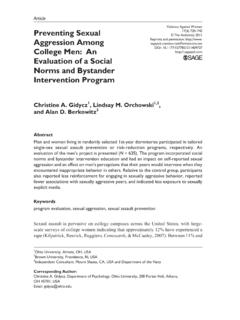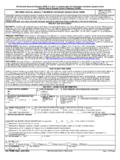Transcription of Department of DefenseCare for Victims of Sexual …
1 Task Force Report on Care for Victims of Sexual assault April 2004. Task Force Composition and Acknowledgments Task Force Members Ms. Ellen P. Embrey, Director Lieutenant Colonel Kenneth A. Arnold Ms. Cynthia Bingham Lieutenant Colonel James Cockerill Lieutenant Colonel Susan G. Dunlow Dr. Terri J. Rau Ms. Jenice Staniford Major Jayme M. Sutton Task Force Administrative Staff Colonel Ray Cunningham Ms. Barbara Goodno Ms. Tracy Sutton Ms. Elizabeth Welton Ms. Jennifer Barchok Ms. Sarah Fanning Task Force Support The Task Force would like to thank the following organizations for their support and advice: Combatant Commanders Joint Staff Department of the Army Department of the Navy Department of the Air Force Department of Defense, General Counsel Department of Defense, Inspector General The Department of Justice The Department of Veterans Affairs Office of the Secretary of Defense, Reserve Affairs Office of the Secretary of Defense, Legislative Affairs Office of the Under Secretary of Defense, Personnel and Readiness Deployment Health Support Directorate Florida State University, School of Social Work, The Honorable Kathleen A.
2 Kearney Center for Military Readiness, Ms. Elaine Donnelly The American Prosecutors' Research Institute The Miles Foundation Rape, Abuse, and Incest National Network ii DoD Care for Victims of Sexual assault Task Force Report Table of Contents Task Force Composition and Acknowledgments .. ii Preface .. v Executive Summary .. vii Task Force Review Methodology ..vii Findings and Care for Victims of Sexual assault ..ix Sexual assault Investigation and x Summary ..xii 1. Introduction .. 1. Reviewing Sexual assault in the Military ..1. Review Plan ..1. Task Force Approach ..2. 2. The Military Environment .. 4. Mission of the Armed Forces ..4. Military Values and Leadership ..4. Military Justice System ..5. Options available under the 3. Where We Are Today Current Policies and Procedures .. 9. Prevention ..9. Reporting ..10. System 4. Task Force Findings .. 18. Sexual assault Data and Prevention ..23. Reporting.
3 28. Response Safety and Response Care for Victims ..34. Response Investigation and System Accountability for Sexual 5. Task Force Recommendations .. 46. Recommendations for Immediate Action ..46. Recommendations for Near-Term Action ..50. Recommendations for Longer-Term Action ..55. DoD Care for Victims of Sexual assault Task Force Report iii 6. Literature Review .. 56. Risk Factors for Sexual assault ..59. Prevention ..62. Reporting ..63. Bibliography .. 70. 74. List of Appendices A. Data Call: Services and Combatant Commands .. 77. B. Focus Group 82. C. Chronology of Surveys, Reports, and Hearings 1988 2004 .. 92. D. A Matrix of DoD and Service Guidance for Response to Sexual assault .. 97. iv DoD Care for Victims of Sexual assault Task Force Report Preface DoD Care for Victims of Sexual assault Task Force Report v vi DoD Care for Victims of Sexual assault Task Force Report Executive Summary The Department of Defense is unequivocal in its commitment to ensure that Victims of Sexual assault be protected, treated with dignity and respect, provided proper medical and psychological care, and that the perpetrators of such assaults be held accountable.
4 Task Force Charter On February 5, 2004, Secretary of Defense Donald Rumsfeld directed the Under Secretary of Defense for Personnel and Readiness, Dr. David Chu, to undertake a 90-day review of all Sexual assault policies and programs among the Services and DoD, and recommend changes necessary to increase prevention, promote reporting, enhance the quality and support provided to Victims , especially within combat theaters, and improve accountability for offender actions. Review Methodology On February 13, 2004, the Under Secretary of Defense for Personnel and Readiness established an eight member Department of Defense Care for Victims of Sexual Assaults Task Force. The Task Force formulated a review plan, which included the following: Request and analyze Sexual assault incidence and demographic data from the Services. Request and assess current DoD-wide, Service-wide and Combatant Command-wide Sexual assault policies and programs.
5 Perform literature review on Sexual assault , including review of prior studies and reports on DoD Sexual assault and related programs. Discuss Sexual assault prevention, reporting, response, and disposition issues with commanders, non-commissioned officers, junior enlisted personnel, service providers (medical, mental health, victim advocate, victim witness advocate, chaplains, law enforcement, investigative agencies, and legal personnel), and Victims . Consult with subject matter experts within the Department of Defense, other federal agencies, civilian experts, and Sexual assault support organizations about matters that should inform our review with respect to prevention, reporting, response, and disposition of Sexual assault cases. For the purposes of the Task Force review, Sexual assault was defined as including the alleged offenses of rape, forcible sodomy, assault with intent to commit rape or sodomy, indecent assault or an attempt to commit any of these offenses.
6 The Task Force conducted visits with 21 military locations in the Continental United States (CONUS), Pacific Command (PACOM), and Central Command (CENTCOM) to evaluate DoD and Service policies and programs for prevention of Sexual assault , supportive care for Sexual assault Victims , and how well these programs transition to combat theater. The DoD Care for Victims of Sexual assault Task Force Report vii structure and composition of the focus groups is discussed in Chapter 1. In all, the Task Force had personal contact with more than 1,300 individuals. Working from scripted questions used at every site, the focus groups discussed issues such as command climate, barriers to reporting, prevention and support policies and practices, feedback mechanisms, best practices, and recommendations for improvements. Comments from focus group participants were obtained with the assurance that their individual comments would not be attributed to them or their organizations.
7 The Task Force reviewed Department of Defense, Service, and Combatant Commander policies and education and training requirements relative to Sexual assault . The Task Force also reviewed selected 2002 and 2003 case and care reports at the sites visited where the identified victim was a uniformed service member. The Task Force also consulted with other principal staff elements within the Office of the Secretary of Defense, outside experts from the Departments of Justice and the Department of Veterans Affairs, as well as respected experts from academia and rape crisis support organizations. Findings and Recommendations This report contains the findings and recommendations of the Department of Defense Care for Victims of Sexual assault Task Force. Throughout this review, the Task Force sought to understand the culture, command structures, and resource limitations when evaluating appropriate courses of action needed to fill gaps in policies and procedures, particularly as they pertain to in-theater care.
8 The findings are intended to provide a high level, comprehensive assessment of the strengths, weaknesses, and gaps in current DoD and Service policies regarding care for Sexual assault Victims . Findings The Task Force identified 35 key findings relevant to current Sexual assault policies and programs among the Services and DoD, and proposed 9 broad recommendations for immediate, near-term, and long-term corrective action. Sexual assault Data and Definition DoD-wide, data systems and records on reports of Sexual assault are incomplete and not integrated. Records are best when criminal investigations were performed, but significant gaps in the documentation of victim care and treatment, victim choices in the disposition process, and command disposition were identified. The implications of this are discussed further in Finding 1. The number of alleged Sexual assault cases reported across the Department of Defense for 2002 and 2003 are discussed in Finding 2.
9 Cases reported to have occurred in the CENTCOM Area of Responsibility are reported as well. The rates of reported alleged Sexual assault were and per 100,000 uniformed service members in 2002 and 2003, respectively. Due to substantial differences in the definition of Sexual assault , these rates are not directly comparable to rates reported by the Department of Justice. viii DoD Care for Victims of Sexual assault Task Force Report There is considerable inconsistency in the legal and behavioral definitions of terms like Sexual assault , Sexual harassment, and Sexual trauma, as discussed in Finding 3. This creates significant challenges for the Department when evaluating Sexual assault trends, both within and outside DoD, and ensuring effective program execution. Despite these challenges, Sexual assault risk factors in the military do not appear to be significantly different from those reported in civilian literature.
10 These commonalities and associated data are discussed in Finding 4. Currently, these identified risks are not being systematically communicated to military members as part of any prevention education efforts that are either directly or indirectly related to Sexual assault . Sexual assault Prevention Existing policies and programs aimed at preventing Sexual assault are inconsistent and incomplete, principally because there is no Defense-wide policy requiring them, as discussed further in Findings 5 and 9. All services have robust programs aimed at prevention of Sexual harassment that tangentially discuss Sexual assault . The Task Force found pockets of excellence in each of the Services to address Sexual assault prevention, response, and support. Examples are provided in Finding 6. Overall, the lack of Department -wide policy and program emphasis is particularly problematic in joint combat environments. Findings 7.
